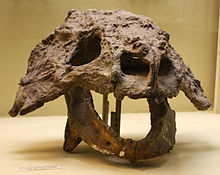Scutosaurus
[2] Fossils have been found in the Sokolki Assemblage Zone of the Malokinelskaya Formation in European Russia, close to the Ural Mountains, dating to the late Permian (Lopingian) between 264 and 252 million years ago.
[4] The first published name of what is now called Scutosaurus karpinskii was in 1917 by British zoologist David Meredith Seares Watson, who captioned a reconstruction of its scapulocoracoid[5] based on the poorly preserved specimen PIN 2005/1535[4] "Pariasaurus Karpinskyi, Amalitz" (giving credit to Amalitskii for the name).
[5] Amalitskii died later that year, and the actual diagnosis of the animal was posthumously published in 1922, with the name "Pareiosaurus" karpinskii,[3] and the holotype specimen designated as the nearly complete skeleton PIN 2005/1532.
In 1987, Russian paleontologist Mikhail Feodosʹevich Ivakhnenko erected a new species "S. itilensis" based on skull fragments PIN 3919, and resurrected "S. tuberculatus", but Australian biologist Michael S. Y. Lee considered both of these actions unjustified in 2000.
[4] Scutosaurus is a common fossil at the North Dvina site, and is known from 6 at least fairly complete skeletons, as well as numerous various isolated body and skull remains, and scutes (osteoderms).
[1] Pareiasaurs, as well as many other common herbivorous Permian tetrapods, had a large body, barrel-shaped ribcage, and engorged limbs and pectoral and pelvic girdles.
[1] All pareiasaurs have broad snouts containing a row of closely packed, tall, blade-like, and heterodont teeth with varying numbers of cusps depending on the tooth and species.
[2] Despite its relatively small size, Scutosaurus was heavy, and its short legs meant that it could not move at speed for long periods of time, which made it vulnerable to attack by large predators.
Subsequent studies—including stable isotope analyses and footprint analyses—on various African and Eurasian remains have all reported results consistent with terrestrial behavior.
In 2016, zoologist Markus Lambertz and colleagues, based on the thin bones and short neck unsuited for reaching low-lying plants, suggested that caseids were predominantly aquatic and only came ashore during brief intervals.
Following this possibly relatively short juvenile period, an individual would have reached 75% of its full size, and continued growing at a slower rate for several years more.
[19] Scutosaurus comes from the Salarevskaya Formation, which has a uniformly red coloration and comprises paleosol horizons, which deposit in cyclically shallow-water and dry area.
Paleosols gradually disappear in the upper part of the formation where the thickness of beds becomes much more discontinuous as well as irregular (from some millimeters to several meters), and the appearance of blue spots which may represent the accumulation of reduced iron oxides.
The formation has typically been explained as the result of several catastrophic floods washing over arid to semi-arid plains during wet seasons, featuring several temporarily filled channels and permanently dry lakes.
[20] Scutosaurus was a member of the pareiasaurian–gorgonopsian fauna dating to the Upper Tatarian, dominated by pareiasaurs, anomodonts, gorgonopsians, therocephalians, and cynodonts.



